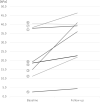Effects of tongue right positioner use on tongue pressure: a pilot study
- PMID: 36841869
- PMCID: PMC9968309
- DOI: 10.1038/s41598-023-30450-0
Effects of tongue right positioner use on tongue pressure: a pilot study
Abstract
The effectiveness of the tongue right positioner (TRP) use on oral and swallowing functions remains unclear. To investigate the effects of TRP use on tongue function in patients with dysphagia. This interventional study included eight participants with dysphagia who visited a university dental hospital. The measurement variables included tongue pressure (TP) as the primary outcome and lip and tongue movements, peak nasal inspiratory flow, and changes in the tongue and suprahyoid muscle regions on ultrasonography as the secondary outcomes. Each participant was asked to use a TRP for at least 8 h every night for 2 months. The measurement variables before and after the intervention were compared using the paired t test and Wilcoxon signed-rank test. TP after intervention (31.5 ± 13.1 kPa) was significantly higher than that before intervention (23.0 ± 13.4 kPa), while other measurement variables did not significantly improve. Numerous exercises have been suggested to improve TP; however, most require patients' adherence to instructions. In contrast, although participants did not perform active exercises, most participants in this study observed an improved TP. Our findings show that TRP can greatly improve TP after 2 months of usage.Trial registration number: University Hospital Medical Information Network Clinical Trials Registry (UMIN000040253, date of first registration: 27/04/2020).
© 2023. The Author(s).
Conflict of interest statement
The authors declare no competing interests.
Figures



References
-
- Aoki Y, Kabuto S, Ozeki Y, Tanaka T, Ota K. The effect of tongue pressure strengthening exercise for dysphagic patients. Jpn. J. Compr. Rehabil. Sci. 2015;6:129–136. doi: 10.11336/jjcrs.6.129. - DOI
Publication types
MeSH terms
Associated data
- Actions
LinkOut - more resources
Full Text Sources
Medical

